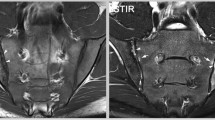Abstract
Background
Definitive diagnosis of occult scaphoid fractures remains difficult. We tested the null hypothesis that, for diagnosis of true fractures among suspected scaphoid fractures, computed tomography (CT) reformations along the long axis of the scaphoid have the same accuracy as reformations made relative to the anatomical planes of the wrist.
Methods
In a prospective trial, 34 patients with a suspected scaphoid fracture underwent CT scanning within 10 days after trauma. CT reformations along the long axis of the scaphoid (CT-scaphoid) and along planes relative to the wrist (CT-wrist) were made. We used radiographs obtained 6 weeks after injury as the reference standard for a true fracture. A blinded panel including two surgeons and one radiologist came to a consensus diagnosis for each reformation plane.
Results
The reference standard showed six fractures of the scaphoid (prevalence, 18 %). Using CT-wrist, a scaphoid fracture was diagnosed in five patients (15 %), with three false positive, four false negative and two true positive diagnoses. Using CT-scaphoid, a scaphoid fracture was diagnosed in five patients (15 %), with one false positive, two false negative and four true positive results. Sensitivity, specificity and accuracy were 33, 89 and 79 % for CT-wrist and 67, 96 and 91 % for CT-scaphoid, respectively. This resulted in positive predictive values of 36 % for CT-wrist and 76 % for CT-scaphoid. Negative predictive values were 87 % for CT-wrist and 94 % for CT-scaphoid. No significant differences were found with the number of patients available.
Conclusions
For diagnosis of true fractures among suspected scaphoid fractures, the diagnostic performance characteristics of CT scans reformatted along the long axis of the scaphoid were better than CT scans in the planes of the wrist, but the differences were not significant.



Similar content being viewed by others
References
Adey L, Souer JS, Lozano-Calderon S, Palmer W, Lee SG, Ring D. Computed tomography of suspected scaphoid fractures. J Hand Surg Am. 2007;32:61–6.
Altman DG, Bland JM. Diagnostic tests 2: predictive values. BMJ. 1994;309:102.
Bain GI, Bennett JD, Richards RS, Slethaug GP, Roth JH. Longitudinal computed tomography of the scaphoid: a new technique. Skeletal Radiol. 1995;24:271–3.
Buijze GA, Mallee WH, Beeres FJ, Hanson TE, Johnson WO, Ring D. Diagnostic performance tests for suspected scaphoid fractures differ with conventional and latent class analysis. Clin Orthop Relat Res. 2011;469:3400–7.
Chen SC. The scaphoid compression test. J Hand Surg (Br). 1989;14:323–5.
Jenkins PJ, Slade K, Huntley JS, Robinson CM. A comparative analysis of the accuracy, diagnostic uncertainty and cost of imaging modalities in suspected scaphoid fractures. Injury. 2008;39:768–74.
Kocher MS, Zurakowski D. Clinical epidemiology and biostatistics: a primer for orthopaedic surgeons. J Bone Joint Surg Am. 2004;86-A:607–20.
Lozano-Calderon S, Blazar P, Zurakowski D, Lee SG, Ring D. Diagnosis of scaphoid fracture displacement with radiography and computed tomography. J Bone Joint Surg Am. 2006;88:2695–703.
Mallee W, Doornberg JN, Ring D, van Dijk CN, Maas M, Goslings JC. Comparison of CT and MRI for diagnosis of suspected scaphoid fractures. J Bone Joint Surg Am. 2011;93:20–8.
Memarsadeghi M, Breitenseher MJ, Schaefer-Prokop C, et al. Occult scaphoid fractures: comparison of multidetector CT and MR imaging—initial experience. Radiology. 2006;240:169–76.
Miettinen OS. The matched pairs design in the case of all-or-none responses. Biometrics. 1968;24:339–52.
Munk B, Frokjaer J, Larsen CF, et al. Diagnosis of scaphoid fractures. A prospective multicenter study of 1,052 patients with 160 fractures. Acta Orthop Scand. 1995;66:359–60.
Ring D, Jupiter JB, Herndon JH. Acute fractures of the scaphoid. J Am Acad Orthop Surg. 2000;8:225–31.
Ring D, Lozano-Calderon S. Imaging for suspected scaphoid fracture. J Hand Surg Am. 2008;33:954–7.
Sanders WE. Evaluation of the humpback scaphoid by computed tomography in the longitudinal axial plane of the scaphoid. J Hand Surg Am. 1988;13:182–7.
Stewart NR, Gilula LA. CT of the wrist: a tailored approach. Radiology. 1992;183:13–20.
Whiting P, Rutjes AW, Reitsma JB, Bossuyt PM, Kleijnen J. The development of QUADAS: a tool for the quality assessment of studies of diagnostic accuracy included in systematic reviews. BMC Med Res Methodol. 2003;3:25.
Acknowledgments
We would like to thank Drs. SP Kamminga, resident in Plastic and reconstructive surgery, for his support to include several patients for this study and Mrs. WA van Enst of the Dutch Cochrane Center for her dedication in the statistical analysis.
Statement of human and animal rights
All procedures followed were in accordance with the ethical standards of the responsible committee on human experimentation (institutional and national) and with the Helsinki Declaration of 1975, as revised in 2008. Written informed consent was obtained from all patients for being included in the study.
Conflict of interest statement
There were no financial or personal relationships with other people or organizations that could inappropriately influence this work. The authors declare that they have no conflict of interest.
Author information
Authors and Affiliations
Corresponding author
About this article
Cite this article
Mallee, W.H., Doornberg, J.N., Ring, D. et al. Computed tomography for suspected scaphoid fractures: comparison of reformations in the plane of the wrist versus the long axis of the scaphoid. HAND 9, 117–121 (2014). https://doi.org/10.1007/s11552-013-9556-z
Published:
Issue Date:
DOI: https://doi.org/10.1007/s11552-013-9556-z




